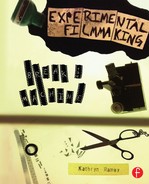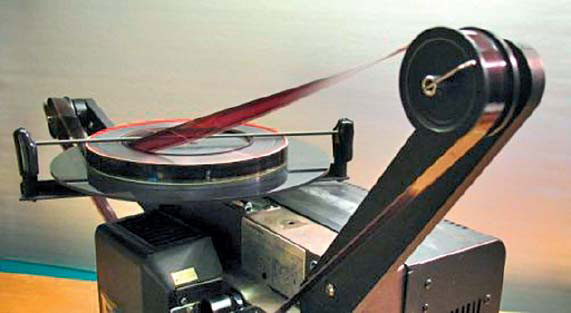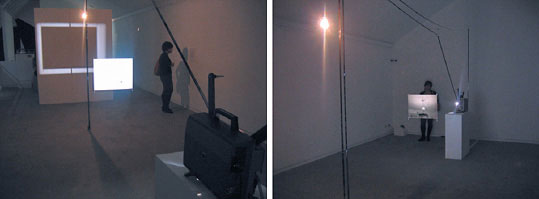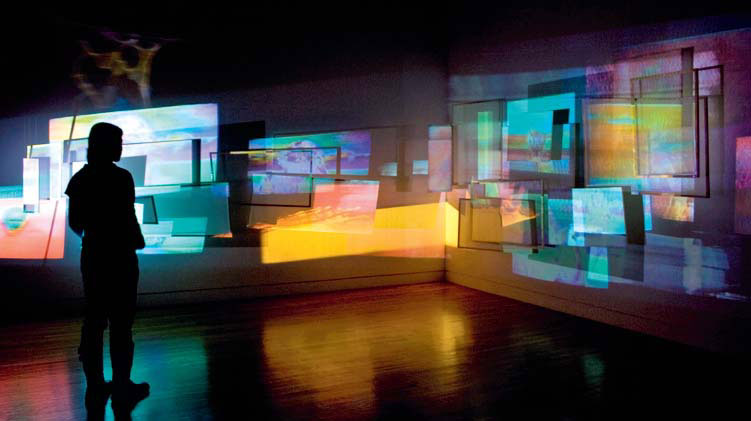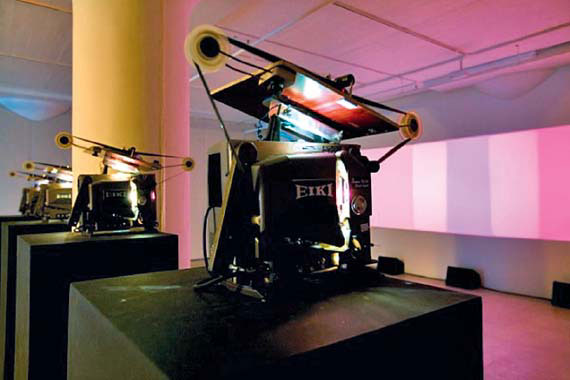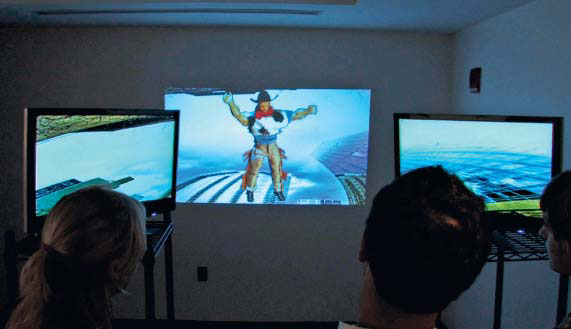Installation indicates pieces that are specifically designed to run on their own, with little or no intervention by the artist. These usually exist in gallery or museum spaces. In a way, the act of installing art transforms the way we think about space into a gallery or museum space and (usually) transforms the viewing experience from one that is collective—in the way theatrical/performance activity is—to one that is individual in which the viewer walks by/around/through the artwork and experiences it singularly or with a few others. Although film installations are ephemeral in a sense, as the art object only exists once it is installed and turned on, installing films for display into a gallery/museum is a move toward thinking about film as an art object that can be produced in limited editions, commodified and sold.
This is not to criticize the artists who work this way, but rather to say that the art world is good at commodifying art objects so that they can be sold and that this market is well established whether the artist who wants to produce these kinds of film works wants to engage in it or not (see Becker 1982 for a discussion of the socio-economic construction of an art world). The avant-garde film world is very bad at commodifying its work and artists who want to do so have been more or less successful in creating an environment of scarcity around their work that would increase its value, such that someone who collects art would find the purchase of a film a good investment.
The distribution strategies of Sharon Lockhart illustrate this difference. Working in both still photography and moving images, Sharon does not exhibit her films in festivals and other venues the way other filmmakers do (showing them as frequently as possible, thus reducing their scarcity) but has very select screenings and/or exhibits only in galleries and then sells limited edition prints of her films alongside her photography. I don’t want to dwell on this too much as I and others have written about the economics of the film avant-garde (Bayma 1995, Ramey 2010), but bring it up to indicate both the economic and social/cultural forces that impact the viewing and distribution of this kind of film and installation work, and should impact how the artist thinks about his or her work as he or she is making it. Who do you want to see/experience your work? What kind of economic experience do you want to engage in? Some of this is of course beyond your control, but understanding the field of possibilities of exhibition and distribution should be an essential part of your artistic production, even if you are only making films for your friends.
Film as installation has also a long history in the film avant-garde and continues to this day, despite the prevalence of video art. Film is a different medium and this interest in its media specificity in installation underscores this difference. To a certain degree installation with film utilizes similar tools to any other experimentalists working in film. In Chapter 1 there are instructions as to how to make a loop. I put them there for the purpose of folks working in direct animation to be able to “test” their animations, but film as installation almost always plays on a loop so that it can play continuously. Most installations play pieces that are longer than the 6ft or so that we discussed in making a test animation. Films for installation can be several seconds to thirty minutes or more. Many artists use the standard 16mm projectors with various rigs built above the projector to allow the film to loop through the projector and play continuously. These rigs are called “loopers” and are often built to order to accommodate the length of the looped film, although a company in New York, NCS Products, makes 16mm mini and “super” loopers (Figure 11.1). For installation the film itself is generally printed onto Estar instead of acetate because Estar (as in polyester) is much more durable and can withstand the hours of continuous projection that are required.
Others create loops that are spatial and sculptural in that they involve a consideration of the gallery space with rollers hung from the walls and ceilings. In the piece by Karen Mirza and Brad Butler represented in Figure 11.2, the space is the central consideration for the way the work is designed. From their website:
FIGURE 11.1
NCS Products Super Duper Looper™, courtesy of NCS Products, New York, NY.
FIGURE 11.2
Documentation of the work Untitled by Karen Mirza and Brad Butler. Courtesy of the artists.
The physical film strip defines the shape/volume of the actual space in which it is displayed. The planes are clearly defined and mapped out in both space and time, from the film plane as the filmstrip passes by the projector gate to the image bearing light resting on the surface of the photograph which stands in as the screen, to the surface of the filmstrip as it passes in front of the light bulb hanging in the space to the double projection of the shadow of the illuminated screen hitting the back wall.
www.mirza-butler.net/index.php?/project/untitled/
Some artists machine all or part of the projection apparatus themselves (or have it machined) so that even the projecting device is a sculptural element, or they rework the environment so that it becomes a sculptural element to collide with the film. A member of the Double Negative Collective in Montreal, Malena Szlam works in a variety of media for her films and installations. She has used both more conventional film and video projection, although nearly always in multiple screen projection, and in her piece Chronogram of Inexistent Time 2 (Figure 11.3) she redesigned the walls of the space to create a three-dimensional screen for her images to project on. In another piece by Szlam, she mounted 35mm gates and lenses onto plexiglass and then the gallery walls. Film loops strung around the room between the gates and the entire apparatus would “turn on” when someone entered the space and set off a motion sensor. The piece Una esfera, cuyo centro està en todas partes (“A Sphere Whose Center is Everywhere”) is both sculptural and produces extraordinary visual sensation through interaction.
Although film as installation does not occupy a large section of what we would consider the yearly output of experimental film worldwide, it has a long and established history. It has occupied dual citizenship between art and experimental film spheres of influence and the mainstream art world. International art star Tacita Dean (see the introduction of this book), though she works in 16mm and 35mm, eschews film festivals and only exhibits her films at galleries and museums. It was her 2011 Turbine Hall piece FILM at the Tate that caused the kerfuffle around all the commercial labs being closed in Britain, and if you watch documentation of the exhibit or listen to interviews around it, she gives a fairly reasoned explanation as to why film is her medium and access to it must be preserved.
FIGURE 11.3
Chronogram of Inexistent Time 2 by Malena Szlam. Image courtesy of the artist.
Film as installation has been a part of experimental practice for at least fifty years. Paul Sharits, Stan VanDerBeek and Carolee Schneemann, among others, were mid-century filmmakers who created film-based installations. In the early 1980s the Museum of Modern Art in New York had two exhibits of film as installation. Although at the time they included artists working in both film and video, video art beginning in the 1960s emerged as a distinct format and eclipsed the output of film in moving-image installation by the mid-1980s. Nevertheless as Dean and Lockhart show, and the artists interviewed in this chapter will attest, there is still space, perhaps growing space, for celluloid as installation in the art world.
Film as installation requires mechanical projectors, prints that can withstand being projected over and over again for days on end, and some sort of looping mechanism that allows the film to feed back into the projector so that it constantly replays. In addition, if you have a multi-projector installation, it is necessary to sync the projectors so that they run in time with each other. An artist who wrangled with these problems and about whom there is significant documentation is Paul Sharits. In particular his Shutter Interface (1975) has been preserved at the Hirshhorn Museum and Sculpture Garden as a part of the Smithsonian Institution collection. They use the film as a case study for the challenges of preservation of time-based media artworks (www.si.edu/tbma/hmsg_sharits) and provide a link to watch a recording of the display (www.youtube.com/watch?v=Syjw1hJAADg).
FIGURE 11.4
Paul Sharits, Shutter Interface (1975). From the Hirshhorn Collection.
Figure 11.4 is an image of Shutter Interface from the Hirshhorn galleries press release. There are four film projectors set up side by side with their areas of projection overlapping by about a third. Thus the center two panels are overlapped on the left and right, and the left- and right-hand panels have only one side of overlap. Each film is composed of various solid colors that cut rapidly from one to another. These solid colors are interspersed with frames of black. The four films are all of different lengths and so, once the projection begins, they provide a seemingly infinite loop of combinations. The piece is elaborating how the shutter in cinema functions to interrupt light and create a flicker, and is an expansion on Sharits’s other flicker film work.
Since I began teaching experimental work at Emerson College I have had a handful of students make films as installation. There was one student whose project was quite memorable for the size and scope of its imagination. He was one of our very first experimental media majors and he wanted to make what sounded to me like a “dream organ”. Much like a “color organ” from the 19th century that would play sounds that were meant to correlate with specific colors, John Tyson (the student) wanted to create a huge analog contraption that would access specific film loops that corresponded to certain dream archetypes. He said about the piece:
This piece sort of grew out of a need or curiosity of mine to explore dreams and the dream-state. For whatever reason, I very rarely remember my dreams, and when I do it’s always just very briefly before waking up. So I decided to interview a bunch of my friends, and anonymize their dreams into abstract elements that could be recombined in different ways as a sort of “lucid dream machine”. Originally, the plan was to produce it all on 16mm and play it back using multiple projectors—but it became clear that, aside from the budget that would’ve been required, logistics would have been difficult (not to mention how loud that many projectors in one room would be). So we decided to produce it digitally and run it off a Mac Pro, which opened up a much bigger degree of interaction from the viewer, as well as different presentation options. I decided on the single projector with dual monitors because if you stand in the “sweet spot” it feels like the monitors fill up your peripheral vision just right, for a “VR without a derpy headset”.
Email with the author
The piece was called Luziden: In dem Träumenden Gehirn and he described it as:
An interactive video triptych by media artist John Tyson that plunges the viewer into the surreal world of lucid dreams. Created using concepts and material from actual dreams gathered by the artist, Luziden allows the viewer to produce a unique visual and aural Freudian dream-state through interaction with a MIDI keyboard. The images are composited in real-time and displayed using two LCDs and a projector, in 720p HD video. It is the artist’s attempt to negotiate the psyche of the individual as it meshes with the Jungian “collective unconscious”.
Because film as installation and performance is less about specific techniques and more conceptually based, and utilizes a variety of material processes already delineated in this text, this chapter is focusing less on instructions and more on interviews. It is my hope that the interviews provide a spectrum of perspectives from which these moving image artists make and exhibit their work that prove inspirational. The chapter will include one or two concept exercises by the artists to get you thinking as well as two very loose “assignments” at the end for you to begin your exploration. Although I’ve mentioned a number of artists (most of whom I’ve actually met) I wanted to include two people whose work I’ve known for a long time and who have worked in both linear pieces intended for exhibition in a cinema-type space and in creating works for installation and gallery-type distribution.
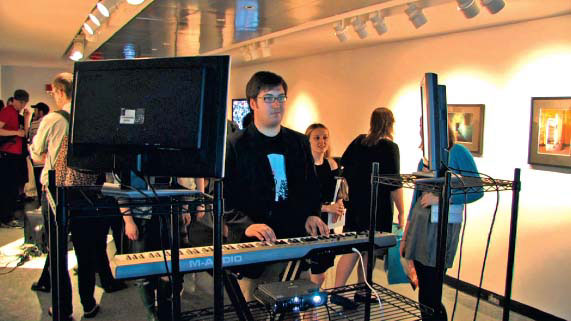
FIGURE 11.5
Gallery attendee playing Luziden at the Huret and Spector Gallery, Emerson College. Image courtesy of the artist.
FIGURE 11.6
Luziden, the “Dream Organ”. Image courtesy of the artist.
Joel Schlemowitz is an artist I first met in the mid-1990s when we both worked at the University of the Arts (with Peter Rose) in Philadelphia. At the time Joel was making films for theatrical exhibition and he was a part of a microcinema called the Robert Beck Memorial Cinema, screening out of the Theater for the Collective Unconscious on Ludlow Street in New York. The group was begun by friends and filmmakers Bradley Eros and Brian Frye (whose Oona’s Veil is discussed in Chapter 1). Joel and I stayed in contact and I ended up interviewing him for my dissertation in Anthropology. I interviewed him in the Long Island City warehouse studio space he shared at the time with Frye, Bruce McClure and a couple of other artists. I remember he had the guts of a piano there as well as a bunch of other interesting ephemera. In my research I was really interested in what kind of upbringing caused a person to become an experimental filmmaker. So I asked Joel if there was something his parents did that prepared him and he said (I am paraphrasing), “It’s not that they brought me up to be an artist, but rather that the way I was brought up made it almost impossible for me to be anything else.” Being an artist is a very particular calling and people come to it in all sorts of ways, but his words have rung in my head ever since. This idea of a certain set of material and social circumstances that don’t point a person towards becoming an artist but rather point them away from other “professions” until being an artist is somehow inevitable: it’s a different way of looking at fostering a particular career in a child.
Joel and I have kept in touch over the years and several years ago he began making work for gallery installation and exhibition. He has made all kinds of optic-related artworks, everything from zoetropes, stereovision hand-held devices, film boxes and film installations. I have included a selection of images from a variety of projects to give you a sense of the works we are talking about in the interview. His biography and a short interview are below.
BIOGRAPHY OF JOEL SCHLEMOWITZ
Joel Schlemowitz is an experimental filmmaker based in Brooklyn, New York. He was the recipient of a Puffin Foundation grant in 2013. Solo shows of his installation works have taken place at Anthology Film Archives and Microscope Gallery in Brooklyn, New York. Solo film shows include the Museum of Modern Art’s Cineprobe series, Millennium Film Workshop, the Robert Beck Memorial Cinema, Anthology Film Archives, Experimental Response Cinema and the Northwest Film Forum. Screenings of his films have included the New York Film Festival, Ann Arbor Film Festival and Tribeca Film Festival. His work has received awards from the Chicago Underground Film Festival, and elsewhere. Schlemowitz writes about experimental film for the poetry and arts community newspaper, Boog City. He is currently working on a feature-length experimental documentary on 78 records. His website is: www.joelschlemowitz.com.
INTERVIEW WITH JOEL SCHLEMOWITZ
Kathryn Ramey: When last we talked (1999 I think) you had not really begun the installation work. So it makes sense to begin the discussion by asking you, how did such a practice evolve? What was it about how you were working in linear form that suddenly made you look towards installation?
Joel Schlemowitz: My drift towards creating installation works in addition to my films came slowly and in stages. The very first pieces, made with toy Super-8 viewers, were as much little gifts for friends as artworks. But I became intrigued by this alternative form of viewing the work. Much more similar to the Edison Kinetoscope, with a single viewer at a time, and the presence of others waiting their turn having a sense of anticipation and intrigue as they observe the reactions of the person peering into the machine without knowing the images provoking the reactions. There’s something appealingly mischievous about this in some way, because seeing someone look into a peephole often suggests a slightly lurid image on the other side when we can’t see what it is.
In 2000 I discovered Anthology’s gallery space as a potential venue for works off the screen. It’s a shame they had to eventually abandon using that basement space for installation and other artworks because there were some wonderful exhibits there including photographs by Robert Haller, video installations by Takashi Murata during the New York Underground Film Festival, and exhibits that every so often related to work that was being shown in the theater above. What I view as the culmination of this was the “Grand Magic Lantern Exhibition!” taking its title from a vintage flyer from the late 19th century that I acquired along with a tin magic lantern from eBay. This consisted of seven 16mm film projectors, projecting onto mirror balls to throw a spray of images around the walls of the space, the footage being images from magic lantern slides. There was also a Victrola to provide a soundtrack, and an oriental rug and brocade pillows on the floor for viewers to make themselves comfortable in viewing the work. The loops themselves were only about 10 seconds apiece, but shot with short cuts and movement so as to hold up to a few viewings without getting dull. There was some thinking in creating the work in this manner of some of the shortcomings of showing more linear or long-duration work in the gallery setting. You can’t really control when the viewer comes along and I’ve seen so many instances of gallery shows where people will walk in during some odd point in a loop being presented, not be able to engage with it, and walk off after a short while. Or if they stick with it they’ll just wait until they’ve gotten to the “this is where we came in” moment and will have watched it rather disjointedly. I think there’s a sort of non-linear and non-durational approach to the film loop that plays to its strengths a little better, and that’s one of the things that I was after with this piece.
The camera-paintings are something that evolved around this same time, realizing that the physical strip of film was hiding a series of images through time that could be viewed simultaneously rather than sequentially. And when the panning or tilting camera was used, you had a view of both time and space, and a relationship between them. And so I would shoot with the camera moving, and then rack it over to do another strip that would be next to it and assemble an image in a light box from all of these strips of images. They turned out the most satisfying when they didn’t line up perfectly but had some overlap, creating an image that would feel a little bit cubist in nature, on the cusp between abstract geometry and recognizable object. It turns out I was by no means the first person to discover this technique. Ross McLaren had shot and assembled 16mm film strips in the same manner back in the 1980s.
Most recently I’ve done 3D collages that are looked at with old stereoviewers to produced the three-dimensional image, shown back in the spring at Microscope Gallery. As with the film-boxes and their Super-8 viewers there’s something interesting within the gallery setting of having the experience of the work be singular in a very different way than the singular viewing we do at home, looking at things on a computer. It’s the interaction between people, waiting to take turns, observing the person peering into the stereoviewer and imagining what they might be seeing.
The most recent of recent pieces is on view right now at Microscope Gallery’s SLIDE SLIDE SLIDE. A piece using 35mm slides and rear projection screens. I’ve used these screens in the past for rather ephemeral art pieces at events (sadly, with little documentation of them back then). And it was one of those lucky moments of happenstance that just as Microscope Gallery was planning a show of work involving slides, the Art History department at Parsons decided it was time to finally get rid of their 35mm art history slides, which had all been digitized at least ten years ago.
I’m working on a new form of 3D pieces now, again using repurposed old technology, but this will not really be ready until some time in the spring. In the meantime, I’m also working on some new camera-paintings that use people in motion to further merge the boundary between the abstract and representational qualities of the work.
KR: How did your installation work then impact your linear work?
JS: There’s often a perceived separation between the “white box” gallery and the “black box” cinema. But I’m interested in the places of convergence of the two. The gray box? Or maybe Holstein cowhide box? This is what I enjoy about places like Microscope Gallery in Bushwick, Brooklyn, with their mandate to link these two often separate worlds. I think this isn’t just about the different groups and the sense of provincialism that can sometimes exist (back when I would go to poetry readings with my partner, the poet Wanda Phipps, there were people who were surprised to discover I wasn’t another poet), but also the need to think about the different modes of working and their different experiences. What I mean by this is an impatience with gallery spaces that will just throw a video projector up and have work play on a loop, maybe even with the added indignity of having sets of headphones to hear the soundtrack.
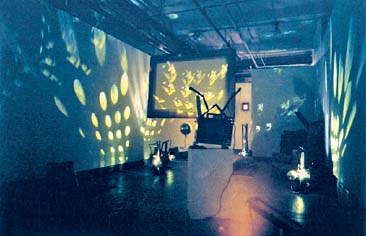
FIGURE 11.7
“Grand Magic Lantern Exhibition!” at Courthouse Gallery, Anthology Film Archives, 2003, by Joel Schlemowitz. Courtesy of the artist.
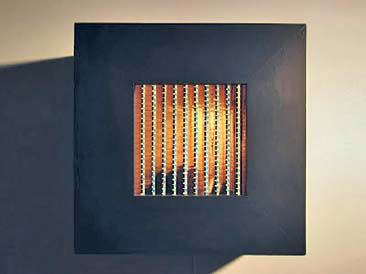
FIGURE 11.8
“Cine-paintings”, 2012, by Joel Schlemowitz. Courtesy of the artist.
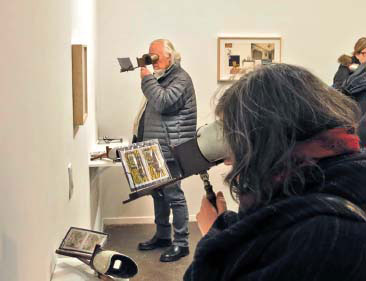
FIGURE 11.9
“Parallax Reveries” stereoscopic collages at Microscope Gallery, 2014, by Joel Schlemowitz. Picture courtesy of the artist and Microscope Gallery.
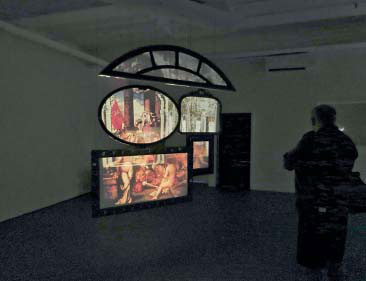
FIGURE 11.10
“A Gallery of Ektagraphic Elegies” from SLIDE SLIDE SLIDE at Microscope Gallery, 2014, by Joel Schlemowitz. Image courtesy of the artist and Microscope Gallery.
Really giving little thought to how the work should be experienced. I’ve never had film pieces shown this way (unless it was without me knowing that it was being done this way). I think it’s a bit of “form follows function” to utilize different viewing experiences in careful, well-planned ways.
KR: You have a variety of installation pieces, from “optical toys” to zoetropes to viewers and rewinds, to multi-projector installations, to film boxes. Can you talk about each of these types of works and how you came to develop them?
JS: The Super-8 viewers used in my early film boxes turned out in retrospect to be a challenging entry point into creating film installation works. They’ve got a tendency to jam and malfunction—after all, it’s just a crude little toy viewer—and so everything after that became easier. Some of this I’ve addressed earlier.
But perhaps it’s a good juncture to say that I find there’s a careful balance that sometimes needs to be achieved between the apparatus and the image. Especially with things like 16mm film. I’ve gone to installation shows where the audience was mesmerized by the mechanical nature of the apparatus and pretty much ignoring the projected images. And so there needs to be some consideration of how much you obscure or reveal the apparatus. A good example of finding just the right place for this was a show by Matt Town at Microscope where he had a loop of 16mm film of the construction of a soap box derby car, then seen prowling along the street, with the projector placed inside a white box that echoed the form of the soap box car itself, and yet provided just enough hint of the apparatus through things like the sound of the projector to be a well-executed balance between the projector and the image where you were attentive to the film but also could see something interesting in the apparatus.
Then there are some cases where the apparatus itself is more critical than the projected image. One piece I recall fondly as an example was a show called “Machine Gut” put together by Katherine Bauer. It was all about the projector as sculptural object—on purpose and not by accident.
KR: How did you come to your particular practice? Did you develop your own processes as a series of experiments? Where did the ideas come from? Does your form and method change as you go and, if so, where have you been and where are you going?
JS: Where do ideas come from … ? Do any of us truly know the answer to this?
KR: What role does media/technology/tools play in your work? What is the relationship between the media/tools and what your work is about? Is your work about something(s)?
JS: I’m interested in the process of working with film and other media technology where there is a reciprocity between the media and the creative process. That is to say, not a version of creating work where it is a headbirth, conceived in some ideal realm of thought and shoehorned onto the form it takes in the real world. But (as I remember reading in a quote from the filmmaker Sam Wells) there is a dialogue between the medium and the artist, the filmmaker tries something and the film says this is how I’ll react if you do that. And then comes that moment of realization that there’s a potential way to work with that reaction in some interesting way. An engaged way of working that acknowledges the medium’s wealth of possibilities. Installation work is just an extension of this question.
The work is about many things, but I’m probably more interested in discovering how the works mean something to others than to explicate the meanings. It’s a bit like trying to explain the joke. This might sound like a cop-out, but talking about what the work is about can often sound a bit hubristic coming from the artist him-/herself.
Explaining humor is a lot like dissecting a frog, you learn a lot in the process, but in the end you kill it.
Mark Twain
The second artist I interviewed for this chapter also works in a variety of forms. For installation, she produces drawings and animations, as well as her film loops. I first met Jenny Perlin through Robin Cline, the friend I mention in the acknowledgements. They were both studying at the School of the Art Institute of Chicago. I also interviewed Jenny for my dissertation and she was generous enough to submit to this most recent round of questioning! Jenny’s practice has always involved installation work, although at times she has also engaged significantly with exhibition in festivals as well. She works very fluidly across animation, film and video, and much of her work centers around what might be called “documentary” or non-fiction interests. She has a passion for research and her work draws on a strong interest in history, language and culture. It is also quite beautiful. One of the things I have most enjoyed communicating with Jenny about as we’ve worked on this interview is perhaps rather mundane. She, like me, is a mother of young children and this experience of working with, in, around these circumstances is nice to share.
BIOGRAPHY OF JENNY PERLIN
Jenny Perlin makes films, videos, installations and drawings. Her projects draw on interdisciplinary research interests in history, cultural studies, literature and linguistics. Her films incorporate innovative techniques to investigate history as it relates to the present. Perlin shoots 16mm film and digital video, and com bines live-action, staged and documentary images with hand-drawn, text-based animation. Her films have been shown as single-channel works and multi-channel installations at numerous venues including the Guggenheim Museum (2011), Mass MoCA (2011), MoMA (2007), Guangzhou Triennial (2008), IFC Center (2008), Berlin and Rotterdam film festivals (2003–2007), the Drawing Center (2001 and 2008) and the Kitchen, New York (2006). Support has come from the LEF Foundation, NYSCA, Experimental Television Center, CEC Artslink, American Center, Geneva, and the Arnold Foundation. Artist residencies include IASPIS Sweden, Wexner Center, Civitella Ranieri, ISCP and commissions from Bard College CCS, Aldrich Museum, BAC Geneva, the Queens Museum and Expo 02, Switzerland.
She received her BA from Brown University in Literature and Society (Modern Culture and Media), her MFA from the School of the Art Institute of Chicago in Film, and completed postgraduate studies at the Whitney Independent Study Program in New York.
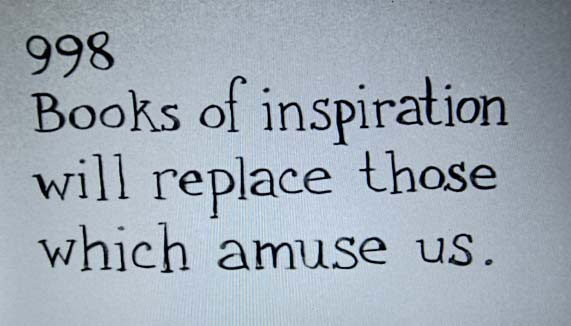
FIGURE 11.11
Still from A Thousand Sentences by Jenny Perlin, courtesy of the Simon Preston Gallery. Jenny Perlin exhibits a 16mm film derived from the work of Caleb Gattegno, a mathematician and educator who pioneered a visual systematic method for teaching foreign languages and mathematics. The film begins with hand-painted animated color fields, each corresponding to a vowel or consonant sound of the English language according to Gattegno’s system. The second part of the film animates excerpts from A Thousand Sentences, Gattegno’s book written to function as a primer for English learners to practice reading simple texts.
Perlin’s work is in public collections including MoMA, Seattle Art Museum, the Five Colleges, MA, the School of the Art Institute of Chicago and numerous private collections. Galleries Annet Gelink and M+R Fricke represent her work in Amsterdam and Berlin. She is currently teaching at the University of Pennsylvania, the Cooper Union and the New School in New York.
INTERVIEW WITH JENNY PERLIN
Kathryn Ramey: So—a general question to get the grease flowing—do you consider yourself an artist, a filmmaker, a new media practitioner, a shaman, a performer? How do you describe who you are/what you do to your aunt or the old guy next door? Or children? Yourself? Your friends? Or do you even try?
Jenny Perlin: Over the years it has been increasingly strange to put a name to me in relation to what I do. So rather than say I’m an artist or filmmaker or such, I say “I make films and drawings, mostly.” When I try to explain to people what I do, I tell them I make films and drawings that have to do with history, with the passage of time, with literature, poetry, music; and with the connections among them. Then I usually give a concrete example from one or another of the projects and try to keep it simple.
KR: How did you come to your particular practice? Did you develop your own processes as a series of experiments? Where did the ideas come from? Does your form and method change as you go and, if so, where have you been and where are you going?
JP: I came to my practice from a deep interest in interdisciplinary work. Choosing film (coming out of literature and history studies) I wanted to find a way to work with all the forms I held near and dear: photography, voice, sound, music, light, reading, conversations, movement, ideas and story. Film seemed the most logical choice. Sixteen millimeter film because that’s what was available then and I immediately felt a connection to that particular medium’s mechanical and historical time period, as that was an area I had been working in in my other studies of late 19th- and early 20th-century literature. I also wanted to do something with my hands, to learn to use tools and particularly I wanted to be a woman who learned to use these tools of image and sound-making. That was important to me. After many years in the more traditional experimental film world I realized that I wanted to be part of an art world that was connected to the questions I was more committed to; less about narrative or storytelling and more about ideas and images and new ways of communicating with and about the medium. I had a harder time with the narrow exhibition formats afforded to the non-traditional films I was making and was far more interested in exploring multifaceted ways of getting my ideas across; not wanting to be limited by one medium or another; wanting to use the medium consciously and not as a transparent “window on my world”; I hoped to make it part of a larger set of questions. Using hand-drawn text animation came first from some drawings I had been doing about the war in Kosovo and then migrating them into 16mm came from several other influences. I was interested in bringing text into film in a way different from voice-over and also different from title. I wanted people to labor to read the film, and to consider that shared labor of reading a shared experience of reading a film; taking time to read together; a process. That’s what brought me to the hand-drawn animation. The crudeness of the animation and its flatness also appealed to me at that time (this was 2000, 2001) because I was utterly sick of what I at the time felt was a lack of the ability of representational images on film to communicate anything except the most banal or clichéd of meanings. I wanted to return film to its flatness, to its “expensive plastic” state and to make it flat as paper and forget about that illusionism. I wanted to make meaning by adjacencies and associations (I was really influenced by Vertov even more than now) and not by the illusion of depth of image, character and a very specifically regulated kind of storytelling that did not appeal. I’ve mellowed with these strong feelings over the years and now integrate live-action with the animated films and also make live-action films in their own right, but this is some of the idea where this kind of work came from.
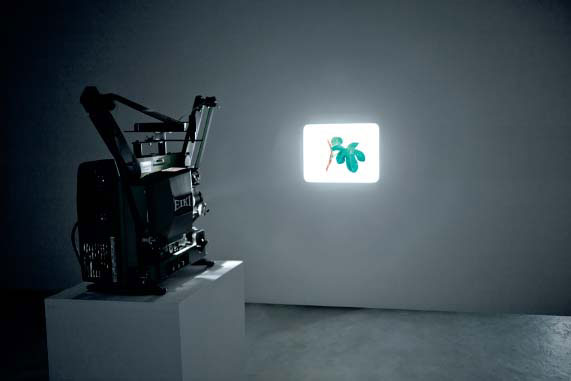
FIGURE 11.12
Jenny Perlin, Funes, Simon Preston, New York, March 4–April 15, 2012. Funes is based on Jorge Luis Borges’s short story about a young man who gains an infallible memory after being thrown by a horse.
KR: What role does media/technology/tools play in your work? What is the relationship between the media/tools and what your work is about? Is your work about something(s)?
JP: Well I always have to answer to the “problem” of using an obsolete technology, and one that becomes sculpture when exhibited. There is a strong relationship between the themes and the medium of most of my work; for example, many of my films are “set” or take place around research in the early and mid-20th century. So film made sense for those. And there is an interest in the medium of film and the typographic typewriterly noisy mechanical quality of the projector and camera as it is made and exhibited. I like the feeling of “wrongness” that comes when watching a mechanical device (projector) work hard to project something that is obviously hand-made and flawed and not mechanically made. But I also make films in HD and in other video media and edit them on the computer and show them digitally when the idea and the project necessitate.
KR: Where do you show your work? How do you want people to experience it? Is there a relationship between the form that your work takes and your desired venue/audience?
JP: I mostly show my work in a gallery or museum exhibition format, though I also show it in film screenings and it is also all available for viewing online. I am interested in the different receptions of the work in the different media, less online because I feel that is more a reference form than an exhibition form for my work. But I love the different reception in a film festival when the space is dark and quiet, and in the gallery when people are moving around. I’m interested in and committed to continuing to explore the tension between these ways of exhibiting.
KR: Are you part of a community of makers (either locally or internationally) who communicate with each other about their work and get together either virtually or physically to discuss/show/celebrate? Where? When? How? What happens?
JP: Yes, I feel so lucky to be part of a great community of interdisciplinary makers, including artists, poets, musicians, fiction and non-fiction writers, documentarians, narrative filmmakers, experimental folks, activists, curators, pedagogues, scholars and my husband and kids. I’ve had a great group that met regularly in a salon format locally to discuss work, and lots of correspondence through virtual means. I feel delighted to know such a diverse and gifted bunch of people, and we all support and exchange with each other regularly.
KR: You know, that is a really important aspect (for female and enlightened male) artists of our generation. In the good ole days artists either didn’t have families, ignored them or (and we all know who we are talking about) used them as their “muse”—pointing the camera AT them but not really having them central to their artistic practice. Can you talk about the role(s) your partner and kids play in your art making? What do they bring to your work that is distinct and wouldn’t exist without them?
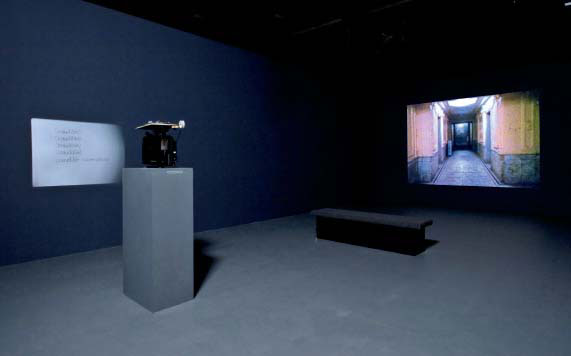
FIGURE 11.13
Jenny Perlin’s Transcript, The Kitchen, New York, NY, 2006. The two works on view evolved from the artist’s research into now-public FBI documents of secretly transcribed conversations from the Red Scare of the 1950s.
JP: OK, now I’ll answer your next question about the family thing. It is interesting to see artists with kids now, finally, in the US culture. That is part of a much longer conversation we can have in person, particularly the one child vs. two (or more) which is a big difference (as you now know!). My work got a lot better and I got a lot better as an artist once I had children. Even though I have only a scrap of time and am doing more “family administration” than I ever imagined possible, my work immediately got more colorful (literally) and more open once I had my children. Having kids freed me up from taking myself and my work so seriously, and certainly there’s not a second to agonize about the work when there are rashes to be dealt with. My partner has always been part of my art-making process; though we don’t collaborate, we do discuss and that is extremely useful. I do wish I had more time to travel with the work and also to fully immerse myself in a project; however, I wouldn’t ever trade this feeling of freedom and flexibility and expansion that’s come as a complete surprise and bonus to me after having had my girls.
Jenny Perlin’s thought experiment
Take the receipts out of your wallet, or wherever you keep them. Look through a few. Don’t put too much thought into which ones. Read them closely. Sometimes there’s a worker’s name. I have one that says “you were served by Shenton”. Try to imagine Shenton, or the person on your receipt whose name you now know. Can you remember her? Try to imagine the day this person had. What she had for breakfast. What time she got to work, what time she might be done; some conversations they may have had or the conversation you may have had with her. Or perhaps there’s something you want to ask her now?
Look again at your receipt. Imagine the person whose job it was to enter all those numbers and words that categorize the things you bought into the machine that printed it out. Imagine who decided how the things that are listed there got organized. Then try to picture the person who made the machine that printed the receipt. Continue apace.
References
Bayma, Todd. “Art World Culture and Institutional Choices: The Case of Experimental Film,” Sociological Quarterly, Vol. 36, No. 1 (1995): 79–95.
Becker, Howard. Art Worlds. Berkeley, CA: University of California Press, 1982.
Ramey, Kathryn. “Economics of the Film Avant-Garde: Networks and Strategies in the Circulation of Films, Ideas, and People,” Jump Cut, No. 52 (2010).
